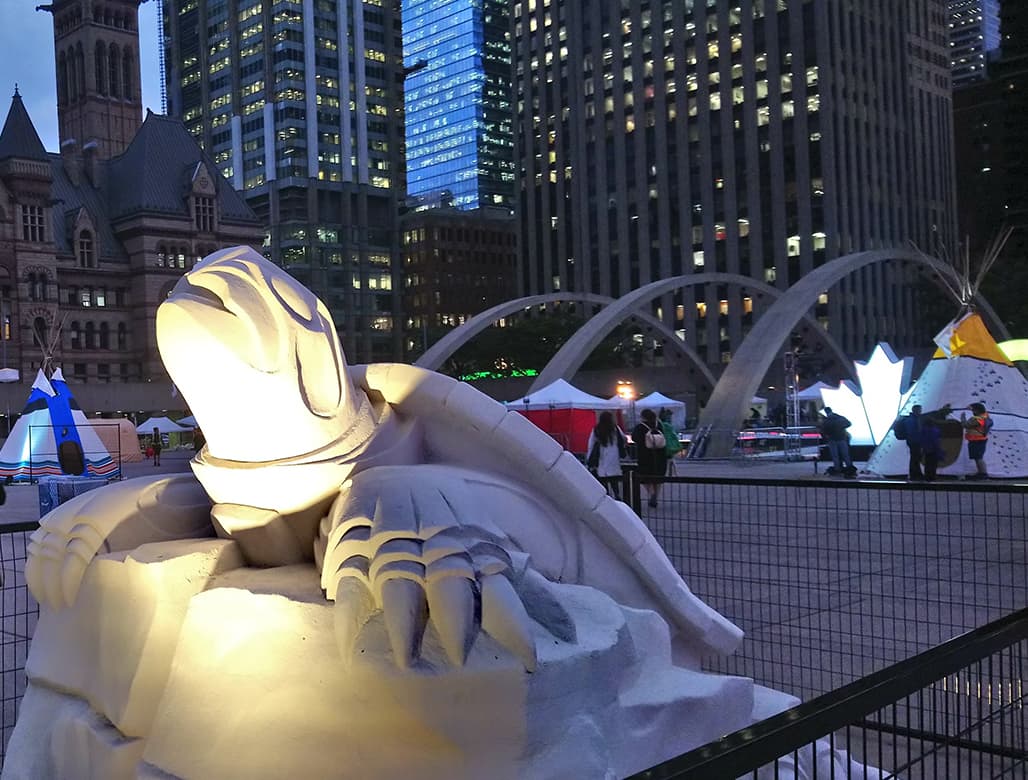Honouring Residential School Survivors
Originally posted in 2018, members of the Central Hub reflect on their participation in the Indian Residential School Survivors’ healing garden launch and legacy celebration.

For a few special days in October, Toronto’s Nathan Philips Square was transformed with the sound of traditional drumming, singing, and dancing and a colourful display of teepees and an Indigenous Artisans’ marketplace. And at the centre of it all was the life size replica of a turtle sculpture, designed by Anishinaabe artist Solomon King, which was unveiled for the launch of the (IRSS) Indian Residential School Survivors’ healing garden: “an inclusive, accessible space with year-round programming held by Elders, traditional teachers, educational institutions and like-minded organizations and working with people of the four directions.”
The 3-day event, which began daily with a Sunrise Ceremony and Restoration of Identity Reaffirmation Walk, also comprised wampum and medicine wheel teachings, ceremonies, and workshops, along with the distinctive opportunity for the diverse Indigenous community to restore their identity and legacy.
The IRSS Legacy project responds to the Truth and Reconciliation Commission of Canada (TRC) Call to Action 82:
“…to commission and install a publicly accessible, highly visible, Residential Schools Monument in each capital city to honour Survivors and all the children who were lost to their families and communities.” In addition to marking this significant milestone, the IRSS Legacy event was a cultural gathering that offered an opportunity to honour residential school survivors and celebrate Indigenous cultural resiliency and diversity.
Several members of Righting Relations’ Central Hub were fortunate to participate in the celebration. Our marketplace booth provided a popular space for visitors to reflect on and discuss their thoughts on building relations between settlers and Indigenous peoples. We collected responses to the question: What does it mean to be an Ally in Truth & Reconciliation? And using a dot-mocracy process, visitors helped identify the most critical Indigenous issues that newcomers and settlers alike need to learn more about.
The most important objective of these activities was to start conversations that hopefully continued with friends, family and colleagues long after the last teepee was taken down. Most encouraging was the number of people who signed onto our mailing list (over 90!) to be advised of future events that will provide opportunities for topics like these to be discussed in more depth.
It was a positive and worthwhile experience for the Righting Relations members volunteering at the booth as is evident from their comments:
“It was such a great day to learn more and have been there in solidarity with Indigenous people” – Najia Zewari
“I personally really enjoyed it, but most importantly I think it brings us closer to where conversations and collaboration are happening around reconciliation. Having a more action-oriented network would allow us to tangibly measure our impact as Adult Educators” – Diana Grimaldos
“…we were well received by attendees, this was apparent from the numerous extensive, personal, honest, critical, reflective conversations that I saw and participated in while I was on site. People wanted to share their reflections in response to our questions and were more than willing/interested in participating in our polls. I hope that the feedback we collected will continue to guide our work in the Central Hub/Southern Circle” – Kaydeen Bankasingh
About the Restoration of Identity Sculpture
Titled Restoring Our Identity, the sculpture will be the centrepiece of the space that will be located at the southwest corner of Nathan Phillips Square. The province is contributing $1.5 million and the city, $500,000. The overall cost is expected to be around $5.2 million, with the remainder being fundraised. Having the Indigenous healing space and statue in a public space outside of City Hall will offer an opportunity for Indigenous and non-Indigenous people to learn about the history represented through the project.
“The sculpture features the snapping turtle climbing over a boulder. Etched in the boulder will list all the residential schools operated in Ontario.
The turtle symbolizes Mother Earth and acknowledges residential school survivors, nations and clans, rooting them back to their rightful place within creation.
This design is based on the traditional Indigenous creation story of Turtle Island. The turtle shell tiles represent the 13 moons in the Indigenous lunar calendar and the 28 surrounding tiles represent the number of days between the new moons. To acknowledge the First Peoples of this region, 13 tiles honours and recognizes the 11 Nations, the Métis Peoples and the Inuit.
The turtle sculpture will be 6 feet tall, 6 feet wide and 9 feet long.”
“With the engagement and interaction of residential school survivors and inter-generational members and collaboration with the City of Toronto, Council Fire is developing a Teaching, Learning, Sharing and Healing (TLSH) space as the home site for our Turtle. The TLSH will be a place for reflection, learning and building of good relations between Indigenous and non-Indigenous peoples.”
To learn more and support this initiative visit: https://irsslegacy.com/celebration/
Posted Under:
allyship, Central Hub, ceremony, decolonization, Indigenous culture, Residential school survivors, tkaronto, Toronto, traditional teachings, truth and reconciliation